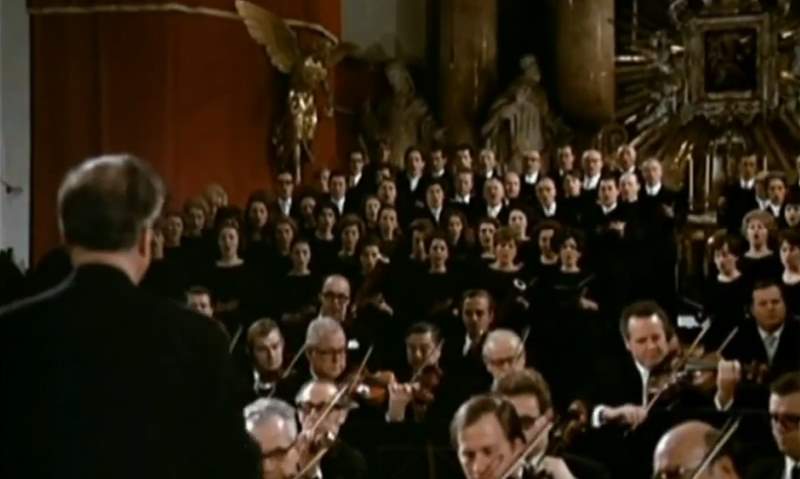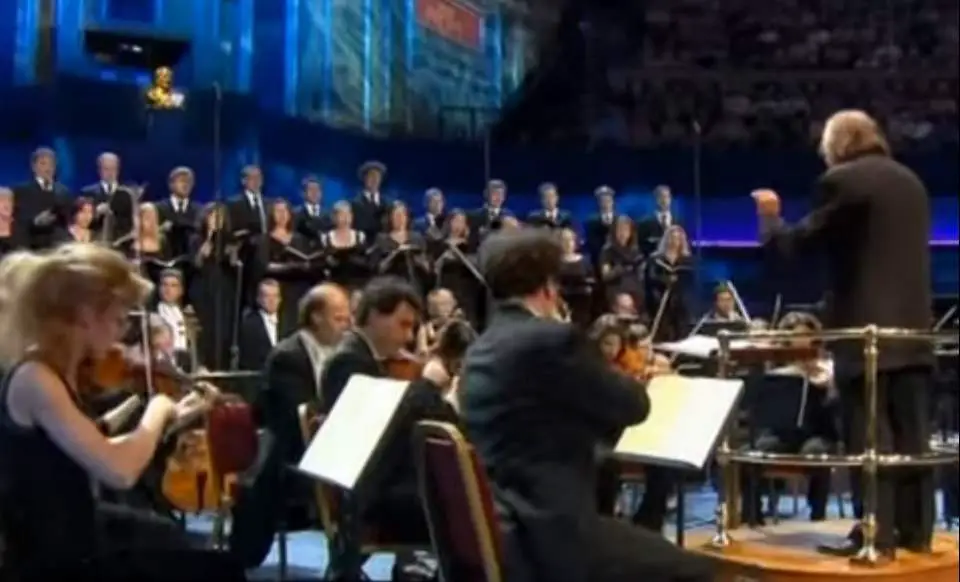Conducted by Herbert von Karajan, the Wiener Singverein and the Wiener Philharmoniker (Vienna Philharmonic Orchestra) perform Wolfgang Amadeus Mozart’s Requiem Mass in D minor (K. 626).
Soloists:
- Anna Tomowa-Sintow, soprano
- Helga Müller-Molinari, mezzo-soprano
- Vinson Cole, tenor
- Paata Burchuladze, bass
Programme
With starting times:
- 2:05 I. Introitus
- 7:34 II. Kyrie
- III. Sequentia
- 10:16 Dies irae
- 12:09 Tuba mirum
- 16:01 Rex tremendae
- 18:22 Recordare
- 23:32 Confutatis
- 25:54 Lacrimosa
- IV. Offertorium
- 29:29 Domine Jesu
- 33:22 Hostias
- 38:00 V. Sanctus
- 39:50 VI. Benedictus
- 45:30 VII. Agnus Dei
- 49:13 VIII. Communio
Wolfgang Amadeus Mozart’s Requiem Mass
The Requiem was composed in Vienna in 1791 and left unfinished at the composer’s death on December 5. A completion dated 1792 by Franz Xaver Süssmayr was delivered to Count Franz von Walsegg, who had anonymously commissioned the piece for a Requiem Mass to commemorate the February 14 anniversary of his wife’s death.
The autograph manuscript (acquired by the Austrian National Library in 1831-1838) shows the finished and orchestrated Introit in Mozart’s hand, as well as detailed drafts of the Kyrie and the sequence, Dies Irae as far as the first eight bars of the “Lacrymosa” movement, and the Offertory. It cannot be shown to what extent Süssmayr may have depended on now-lost “scraps of paper” for the remainder; he later claimed the Sanctus and Agnus Dei as his own.
Walsegg probably intended to pass the Requiem off as his own composition, as he is known to have done with other works. This plan was frustrated by a public benefit performance for Mozart’s widow Constanze. A modern contribution to the mythology is Peter Shaffer’s 1979 play Amadeus, in which a mysterious messenger orders Mozart to write a requiem mass, giving no explanation for the order; Mozart (in the play) then comes to believe that the piece is meant to be the requiem mass for his own funeral.
After Mozart’s death, the task of completing the unfinished parts of the Requiem was given to Franz Xaver Süssmayr, a student of Mozart, though other composers might have had a hand in its completion as well. This was done partly to ensure that the final payment from the commissioner could be secured. While the majority of the work is undeniably Mozart’s, the extent of Süssmayr’s contributions (and possibly others) has been a topic of debate among scholars.
The Requiem is scored for 2 basset horns in F, 2 bassoons, 2 trumpets in D, 3 trombones (alto, tenor & bass), timpani (2 drums), violins, viola and basso continuo (cello, double bass, and organ). The vocal forces include soprano, contralto, tenor, and bass soloists and an SATB mixed choir.
The myths surrounding Mozart’s Requiem, partly fueled by plays and films like “Amadeus,” have contributed to its legendary status. However, beyond the myths, the music stands on its own as a testament to Mozart’s genius. It remains a cornerstone of choral repertoire and is performed frequently around the world.
Anna Tomowa-Sintow
Anna Tomowa-Sintow (born 22 September 1941, in Stara Zagora) is a Bulgarian soprano who has sung to great acclaim in all the major opera houses around the world in a repertoire that includes Mozart, Rossini, Verdi, Puccini, Heinrich Marschner, Wagner, and Strauss. She enjoyed a particularly close professional relationship with conductor Herbert von Karajan from 1973 until his death in 1989.
Helga Müller-Molinari
Helga Müller-Molinari (b. 1948) is a German mezzo-soprano. She managed an extensive stage and concert repertoire, the high picks of which were the W.A. Mozart repertoire and works from the Baroque period.
Vinson Cole
Vinson Cole (born November 21, 1950) is an American operatic tenor. worked with many of the world’s leading conductors including Herbert von Karajan, Sir Georg Solti (with whom he recorded the Mozart Requiem on the 200th anniversary of the composer’s death), Seiji Ozawa, Sir Simon Rattle, Kurt Masur, Edo de Waart, Charles Dutoit, Michael Tilson Thomas, Gerard Schwarz, Andrew Davis, Zubin Mehta, Riccardo Muti, Carlo Maria Giulini, Vladimir Ashkenazy, Claudio Abbado, and Daniel Barenboim.
Paata Burchuladze
Paata Burchuladze (born 12 February 1955) is a Georgian operatic bass. After his debut in his native Tbilisi in 1976, he embarked on a 35-year-long musical career during which he made appearances at leading opera houses across Europe and the United States.

Related: Mozart – Requiem [Michel Corboz]
Sources
- Requiem (Mozart) on Wikipedia
- Vinson Cole on Wikipedia

